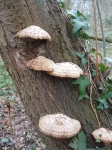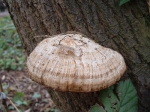
Photos ©1999–
Click any photo for a larger image



Photos ©1999–
Click any photo for a larger image

Oak Mazegill - Daedalea quercina
Family - Fomitopsidaceae
Also known as - Maze–gill fungus
This fungus is poisonous
The Oak Maze–gill fungus Daedalea quercina, so named from the wide gill–like pores that are aligned in a pattern that resembles a maze, is a saprobic species of mushroom used as the type species of the genus Daedalea. Commonly found on standing trees or fallen Oak timber where it causes Brown Rot from a lignin degrading enzyme laccase. The sessile, fan–shaped fruiting bodies are typically 3–20cm (1.2–8in) in diameter and up to 8cm (3in) thick., often solitary but occasionally in tiers, this imposing bracket fungus is less often seen on other kinds of hardwood timber such as Sweet Chestnut, – Fagus spp. and – Fraxina spp.. Found across Europe, North Africa, Asia and Australia, essentially wherever there are Oak species. The upper surface may be various shades of brown but is rather variable, and sometimes zoned. The underside pores attains its characteristic maze–like appearance as the fruiting body matures. On standing dead trees or stumps they have a semi–conical shape as seen in the pictures.
BCP do not advise or recommend that Oak Mazegill – Daedalea quercina is eaten or used as an herbal remedy. This mushroom is inedible due to its cork–like texture. Apparently Oak Mazegill fruiting bodies have been used as a natural comb for brushing down horses.
Site design ©1999– Brickfields Country Park - Privacy -